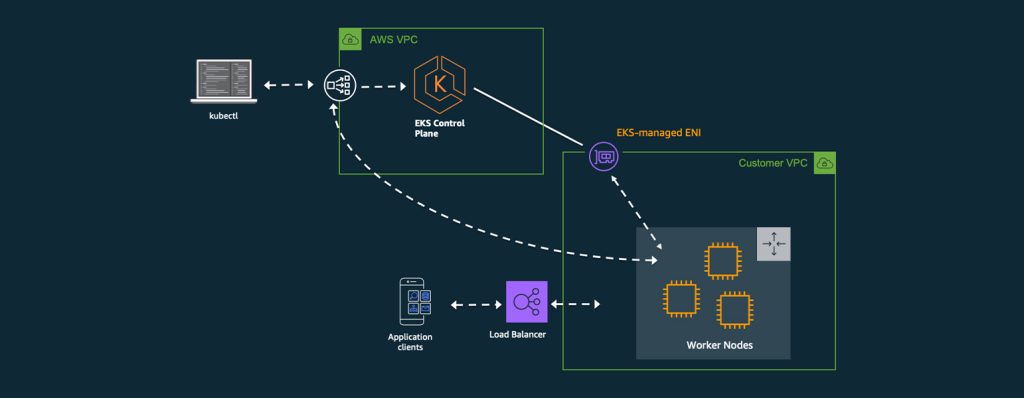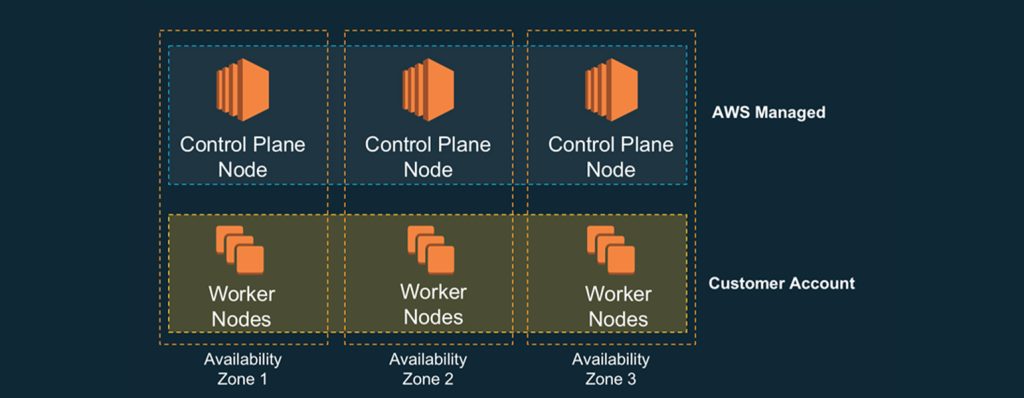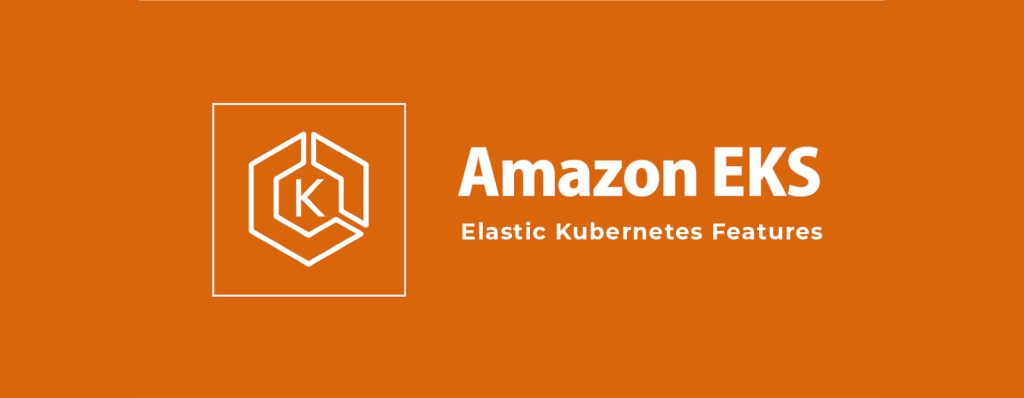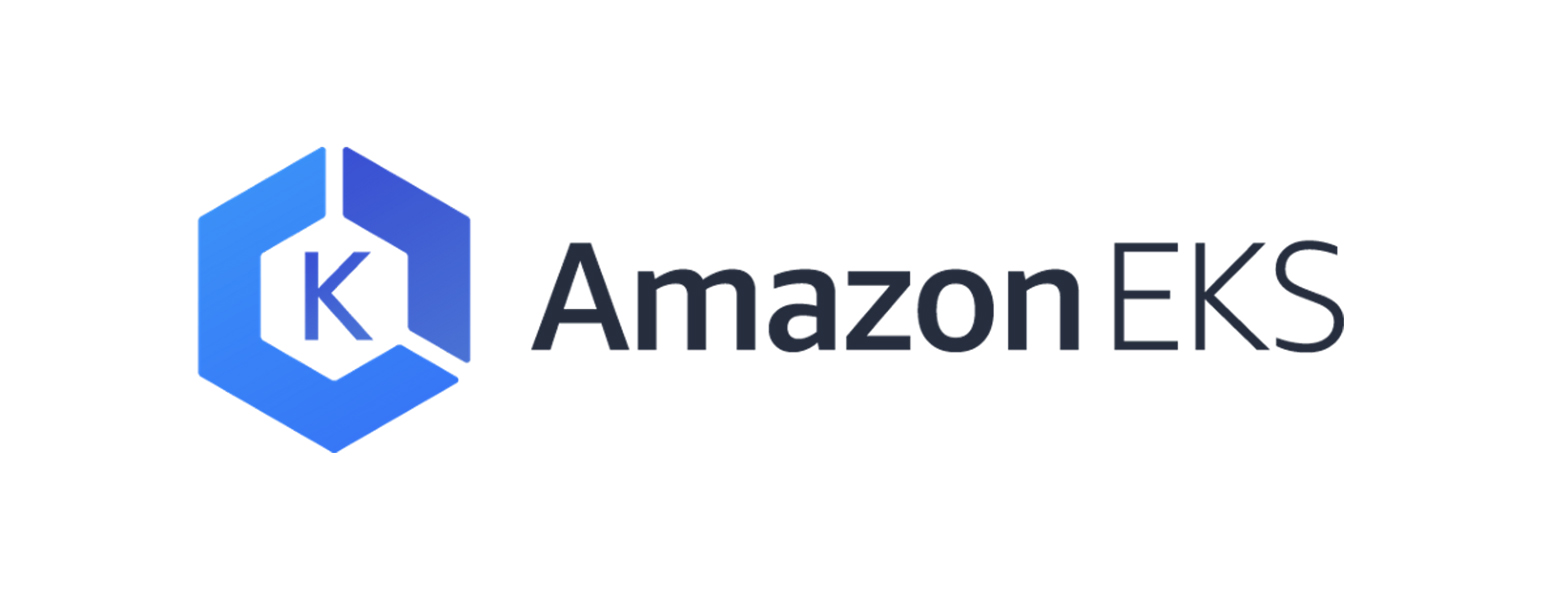Building, securing, running, and maintaining Kubernetes clusters on AWS is made easier with the help of Amazon Elastic Kubernetes Service (Amazon EKS), a fully managed, certified Kubernetes conformant service. To provide a smooth experience for monitoring, scaling, and load balancing your containerized applications, Amazon EKS interfaces with key AWS services including CloudWatch, Auto Scaling Groups, and IAM.
Additionally integrated with AWS App Mesh, Amazon Elastic Kubernetes service EKS offers a Kubernetes-native experience for service mesh consumption. It gives applications strong observability, traffic management, and security features. For Kubernetes workloads, Amazon EKS offers a scalable, highly available control plane. As with Amazon ECS, you have the option to use EC2 instances or AWS Fargate to power your containers when executing apps on Amazon EKS. Organizations migrating to AWS with existing Kubernetes setups may find Amazon EKS to be a useful option as it enables them to use open-source Kubernetes tools and plugins.
What is Amazon EKS?

You can operate Kubernetes on the AWS Cloud using Amazon EKS (Amazon Elastic Kubernetes Service), a managed service, without having to set up, manage, or maintain your own control plane and nodes.
An open-source tool called Kubernetes streamlines the setting up, scaling, and administration of containers, or containerized applications.
EKS scales and runs the Kubernetes control plane across many AWS Availability Zones to achieve high availability. In Amazon (Amazon Elastic Kubernetes Service), control plane instances are automatically scaled based on load. And unhealthy control plane instances are identified and removed, automated version updates and patching are carried out automatically, and unhealthy control plane instances are discovered and replaced.
Various facilities can be provisioned using EKS (Amazon Elastic Kubernetes Service) in conjunction with other AWS services. For instance, AWS EC2 Instances, ECR (Elastic Container Registry) for Container Images, and VPC (Virtual Private Cloud) for resource isolation can all be used to supply worker nodes.
Amazon EKS Cluster Components

Amazon EKS cluster consists of two important components.
1. Control Plan EKS
Nodes that run Kubernetes software, such as etcd and the Kubernetes API server, make up the Amazon EKS control plane. The Kubernetes API is accessible through the Amazon EKS endpoint for your cluster, and the control plane runs on an AWS account. Each single-tenant, one-of-a-kind Amazon EKS cluster control plane contains its own set of Amazon EC2 instances.
The EKS Control plane is accessible across multiple availability zones; in the event that any of the control planes encounter an issue. EKS instantly locates the problematic control plane nodes and replaces them. Additionally, offering on-demand, zero-downtime updates and patching.
2. Nodes EKS
Through an API server endpoint and a certificate file created for your cluster, Amazon EKS nodes operating in your AWS account connect to the control plane of your cluster. To provision the nodes in the EKS cluster, Node Groups must be created.
One or more nodes make comprise a node group. Each node group in an Amazon EC2 Auto Scaling group consists of one or more Amazon EC2 instances. All of which must be of the same type and use the same Amazon Machine Image (AMI). The same IAM role should also be used by a Node Group.
Elastic Kubernetes Service Cluster Deployment Methods
You can create the EKS Cluster in two ways.
Amazon EKS – eksctl: A straightforward command-line tool for building and managing Kubernetes clusters is called eksctl by Amazon EKS. On eksctl, a tool that greatly facilitates the process of setting up EKS clusters, AWS and Weaveworks worked together. The preferred approach for resource provisioning with EKS cluster configuration version control is through a config file, which Eksctl also supports.
AWS Management Console and AWS CLI: The simplest way to build an (Amazon Elastic Kubernetes Service) cluster is through the AWS Management Panel and AWS CLI. You may launch EKS as a service in AWS and add nodes by creating Node Groups within the AWS console.
How (Amazon Elastic Kubernetes Service) Works

The simplest approach to conceptualize Amazon EKS is as Kubernetes as a Service by AWS Cloud.
The EKS Control Plane/Master and Data Plane/Worker nodes, which are building the EKS cluster, are the two main components of Amazon EKS, as was before mentioned. There is a separate Virtual Private Cloud for each of the two planes (VPCs).
The nodes in VPCs host the container images or workloads. The networking infrastructure needed to connect these components and build a Kubernetes cluster is additionally provided by AWS.
AWS Fargate, self-managed nodes, Amazon EKS controlled node groups, and an Amazon EKS cluster can all be used to schedule pods.
Amazon EKS nodes running under your account connect to the cluster via the cluster’s API server endpoint.
Deployment Of Applications

The following details illustrate the deployment of applications in the (Amazon Elastic Kubernetes Service) Cluster.
Provision Amazon EKS Cluster – Provisioning Master The AWS Management Console, AWS CLI, or one of the AWS SDKs can all be used to construct the Cluster.
Deploy Compute – Provisioning Worker from Amazon EC2 Instances or AWS Fargate, compute nodes can be launched. EKS offers the following options for setting up worker nodes to run application containers.
Self-Managed: Provisioning EC2 instances that are connected to the cluster is the user’s responsibility. As a result, you have more options when configuring worker nodes.
Managed: Managed node groups to streamline the provisioning and lifecycle management of nodes for Amazon EKS Kubernetes clusters (Amazon EC2 instances).
AWS Fargate: You may run container apps using Fargate, an AWS-managed serverless computing engine, without having to worry about maintaining servers.
Connect with Amazon EKS Cluster Using the command-line tool Kubectl, Kubernetes communicates with its cluster. Install kubectl on your computer, then set it up to connect to Amazon EKS and run applications.
Monitor Kubernetes Apps To administer and monitor your EKS Cluster when you’ve finished building it, deploy Kubernetes dashboard, a Web-Based Management Interface.
Read more blogs: Comprehensive Overview of Amazon Elasticsearch Service
Utilize EKS on the Cloud to deploy Applications
Amazon Elastic Kubernetes Service Features

Here are some listed important features of Amazon EKS.
1. Control Plane Management
A highly accessible control plane with an automated scalability option is offered by Amazon EKS. The sick control plane is immediately detected and replaced by Amazon Elastic Kubernetes Service because it is operating in three Availability Zones.
2. Integration of Services
You may manage AWS services directly from your Kubernetes environment with the help of AWS Controllers for Kubernetes (ACK). ACK simplifies building scalable and highly available Kubernetes apps using AWS resources.
3. Single line management with Eksctl
It is a command-line application that can be installed on a Windows or Linux computer and used to set up, administer, and operate an EKS cluster. Operations and Cluster Management are made simpler by it.
4. Security
To deliver the highly secure environment, Amazon Elastic Kubernetes Service connects with numerous Services and Technologies. For instance, IAM offers fine-grained access control, and VPC separates and guards against unauthorised access to your EKS cluster.
5. balancing loads
Application Load Balancer, which is perfect for sophisticated load balancing of HTTP and HTTPS traffic, is supported by Amazon EKS. Additionally, Network Load Balancer and Classic Load Balancer are used by EKS.
6. Clientless Computing
EKS supports AWS Fargate for serverless computing to run your Kubernetes apps. Fargate does away with the requirement to install and manage servers. You can select and pay for resources according to the applications.
7. Dual Deployment in Elastic Kubernetes Service
With the least amount of latency to on-premises systems, containerized apps can be run on ‘AWS Outposts’ using EKS. With the help of AWS Outposts, any connected location can access AWS infrastructure, services, APIs, and tools. It is a fully managed solution. With Amazon Elastic Kubernetes Service on Outposts, you can manage containers just as easily on-premises as you can in the cloud.
8. Access to open-source software
Amazon EKS is largely compatible with Kubernetes Community tools and supports standard Kubernetes add-ons.
Updates for Managed Cluster
Kubernetes version changes may be done immediately, so moving apps to a new cluster or building new clusters is unnecessary.
You already know how awesome Kubernetes is if you use it. You have the scalability to smoothly adapt to unforeseen variations in traffic. Due to Kubernetes’ daily management of storage, logging, networking, and workflow for all of your containers, your container workflow is automated and streamlined.
When running on Amazon Elastic Kubernetes Service, Kubernetes supports your business objectives even better (EKS). Kubernetes can offer even greater advantages in terms of managing, deploying, and scaling containerized applications when it runs on Amazon EKS. It is the ideal option to run containers on Amazon Web Services. Because it provides a tonne of flexibility and a robust ecosystem (AWS).
It is simpler to work with current container infrastructure or migrations when Kubernetes is running on Amazon EKS. You may handle nodes or containers more precisely and customise them thanks to it. By doing this, you can use the larger Kubernetes ecosystem more effectively. It might be time to think about migrating if you don’t currently run Kubernetes on Amazon EKS. Since it might help you increase availability while optimising the financial gains and overall worth of your Kubernetes investment.
The Advantages Of The Amazon Elastic Container Service
There are many enlightening advantages to discovering when it comes to deploying Kubernetes on Amazon Elastic Kubernetes Service. Due to the fact that Amazon EKS is a fully managed service. You can take use of all the benefits of Kubernetes without having to hire an internal specialist or deal with the hassle of managing your own infrastructure. Administrators can instead concentrate on their clusters and workloads. Because EKS eliminates the requirement to architect high availability and scalability for your master nodes. EKS automates load distribution and parallel processing faster and more effectively than any human could. Regardless of the workloads, you run—from web applications to databases.
You don’t need to set up, run, or maintain your own Kubernetes control plane when you have Amazon EKS. Instead, you can use the Kubernetes Dashboard to control the applications that are running on your cluster or modify specific resources. With EKS being a certified Kubernetes conformant, running tools and plugins created by the Kubernetes open-source community are simple. And while it can be difficult to scale, protect, and maintain Kubernetes, Amazon Elastic Kubernetes Service makes creating a cloud-native architecture in AWS simpler.
What’s More About Elastic Kubernetes Service
Amazon EKS is still used and has several advantages. EKS, which makes use of VPC networking, enables you to effortlessly combine your present Kubernetes assets with AWS services. Though please refer to the IP addresses per ENI type when sizing your networks, as EKS worker nodes allocate the maximum per worker node. In addition, since any application running on Amazon EKS is compatible with any application running in your current Kubernetes environment. you may switch to EKS without changing any code. The fact that you won’t need to hire a single developer is wonderful news for your budget. By enabling pods to take on IAM responsibilities and expanding native Kubernetes load balancer support to include ALB, tools like KIAM and ALB Ingress Controller improve the functionality of EKS.
Are you still unsure that using EKS for Kubernetes makes a difference? What if we told you that Amazon Elastic Kubernetes Service maintains availability by running three masters of Kubernetes across three AWS availability zones? Or that automatic patches can be applied by EKS while also automatically identifying and replacing subpar masters? With all of these advantages and features, Amazon Elastic Kubernetes Service offers the best Kubernetes scalability, deployment, and monitoring you can get for the Cloud.
To save you time and effort, 0Scale offers guidance and expertise in EKS.
You can use your own Kubernetes cluster, Amazon Elastic Container Service (Amazon ECS), or Amazon Elastic Container Service (Amazon EKS) to host containers on AWS. If you manage your own cluster, you’ll need qualified IT people on staff, which is a significant expense. This also puts the onus of maintaining current Kubernetes skills squarely on your company. Alternatively, you could use Amazon ECS, but that only provides a managed docker service without the service discovery, open-source improvements, and community support of Amazon Elastic Kubernetes Service.
The AWS Advanced Consulting Partner that has the most experience managing, deploying, and scaling. Containerized applications on Amazon EKS is what your business actually needs. One that can assist you in achieving your company objectives by providing you with the knowledge, tools, and strategic insight necessary to make the most of EKS, right down to the last advantage.
Getting Started
Kubernetes is a flexible technology that provides you endless scalability at a moment’s notice for automating and streamlining your container process. Running it on Amazon EKS, where it can utilise multiple AWS availability zones to avoid single failure spots, is unquestionably the best option for your company. Any applications currently running in your Kubernetes environment will be compatible with Amazon EKS and be simple to move to. And the open-source community has created a range of plugins and other tools that are included with Amazon EKS. Migration, however, is a significant project that you should hand off to AWS Certified Engineers.
0Scale is your go-to partner for the expertise, know-how, and support you need for a smooth implementation and superior container management going forward. Let us handle the heavy lifting when you’re ready to transfer your Kubernetes infrastructure and applications to Amazon EKS. More efficiently and expertly than any internal IT team. Our AWS-certified engineers can migrate, run, and manage any part of your Kubernetes infrastructure on Amazon Elastic Kubernetes Service.
You may use 0Scale’s extensive services and in-depth knowledge to fully utilise Kubernetes on Amazon EKS, from round-the-clock monitoring to thorough regular maintenance. We liberate your company so that your employees can focus solely on achieving your main business goal without being distracted.


